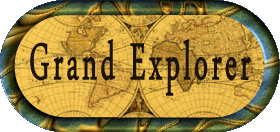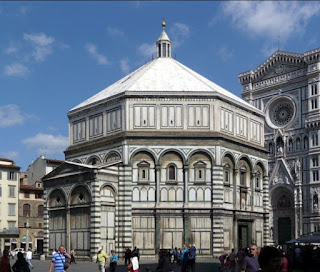I think the saying "Keeping the best for last" truly applies here as today we sailed into Venice! This city is in northeastern Italy sited on a group of 118 small islands separated by canals and linked by bridges. It is located in the marshy Venetian Lagoon which stretches along the shoreline, between the mouths of the Po and the Piave Rivers. Venice is renowned for the beauty of its setting, its architecture, and its artwork. The city in its entirety is listed as a World Heritage Site, along with its lagoon.
The name is derived from the ancient Veneti people who inhabited the region by the 10th century BC. The city was historically the capital of the Republic of Venice. Venice has been known as the "La Dominante", "Serenissima", "Queen of the Adriatic", "City of Water", "City of Masks", "City of Bridges", "The Floating City", and "City of Canals".
The Republic of Venice was a major maritime power during the Middle Ages and Renaissance, and a staging area for the Crusades and the Battle of Lepanto, as well as a very important center of commerce (especially silk, grain, and spice) and art in the 13th century up to the end of the 17th century. This made Venice a wealthy city throughout most of its history. It is also known for its several important artistic movements, especially the Renaissance period. After the Napoleonic Wars and the Congress of Vienna, the Republic was annexed by the Austrian Empire, until it became part of the Kingdom of Italy in 1866, following a referendum held as a result of the Third Italian War of Independence. Venice has played an important role in the history of symphonic and operatic music, and it is the birthplace of Antonio Vivaldi.
 By the late 13th century, Venice was the most prosperous city in all of Europe. At the peak of its power and wealth, it had 36,000 sailors operating 3,300 ships, dominating Mediterranean commerce. Venice's leading families vied with each other to build the grandest palaces and support the work of the greatest and most talented artists. The city was governed by the Great Council, which was made up of members of the noble families of Venice. The Great Council appointed all public officials and elected a Senate of 200 to 300 individuals. Since this group was too large for efficient administration, a Council of Ten (also called the Ducal Council or the Signoria), controlled much of the administration of the city. One member of the great council was elected "Doge", or duke, the chief executive, who usually held the title until his death; although several Doges were forced by pressure from their oligarchical peers to resign and retire into monastic seclusion when they were felt to have been discredited by political failure.
By the late 13th century, Venice was the most prosperous city in all of Europe. At the peak of its power and wealth, it had 36,000 sailors operating 3,300 ships, dominating Mediterranean commerce. Venice's leading families vied with each other to build the grandest palaces and support the work of the greatest and most talented artists. The city was governed by the Great Council, which was made up of members of the noble families of Venice. The Great Council appointed all public officials and elected a Senate of 200 to 300 individuals. Since this group was too large for efficient administration, a Council of Ten (also called the Ducal Council or the Signoria), controlled much of the administration of the city. One member of the great council was elected "Doge", or duke, the chief executive, who usually held the title until his death; although several Doges were forced by pressure from their oligarchical peers to resign and retire into monastic seclusion when they were felt to have been discredited by political failure.
The Black Death devastated Venice in 1348 and once again between 1575 and 1577. In three years, the plague killed some 50,000 people. In 1630, the plague killed a third of Venice's 150,000 citizens. Venice began to lose its position as a center of international trade during the later part of the Renaissance as Portugal became Europe's principal intermediary in the trade with the East, striking at the very foundation of Venice's great wealth; while France and Spain fought for hegemony over Italy in the Italian Wars, marginalizing its political influence. However, the Venetian empire was a major exporter of agricultural products and, until the mid-18th century, a significant manufacturing center.
During the 18th century, Venice became perhaps the most elegant and refined city in Europe, greatly influencing art, architecture and literature. But the Republic lost its independence when Napoleon Bonaparte conquered Venice on 12 May 1797 during the First Coalition. Napoleon was seen as something of a liberator by the city's Jewish population, although it can be argued they had lived with fewer restrictions in Venice. He removed the gates of the Ghetto and ended the restrictions on when and where Jews could live and travel in the city.
The buildings of Venice are constructed on closely spaced wooden piles. Most of these piles are still intact after centuries of submersion. The foundations rest on plates of Istrian limestone placed on top of the piles, and buildings of brick or stone sit above these footings. The piles penetrate a softer layer of sand and mud until they reach a much harder layer of compressed clay. Submerged by water, in oxygen-poor conditions, wood does not decay as rapidly as on the surface.
The city today is still a marvel of gondolas and glassware shops along the backdrop of magnificent palaces at every turn. We purchased a day pass for the transportation system and we were able to visit St. Mark's Square and the surrounding areas.
We then headed out to Murano to see the glass-blowers. Murano is a series of islands linked by bridges in the Venetian Lagoon in northern Italy. It lies about 0.9 miles north of Venice and measures about 0.9 mi across with a population of just over 5,000. It is famous for its glass making. It was once an independent comune, but is now a frazione of the comune of Venice.
In 1291, all the glassmakers in Venice were forced to move to Murano due to the risk of fires. In the following century, exports began, and the island became famous, initially for glass beads and mirrors. Aventurine glass was invented on the island, and for a while Murano was the main producer of glass in Europe. The island later became known for chandeliers. Although decline set in during the eighteenth century, glassmaking is still the island's main industry.
Murano's glassmakers were soon numbered among the island’s most prominent citizens. By the fourteenth century, glassmakers were allowed to wear swords, enjoyed immunity from prosecution by the Venetian state and found their daughters married into Venice’s most affluent families. While benefiting from certain statutory privileges, glassmakers were forbidden to leave the Republic. However, many of them took the risks associated with migration and established glass furnaces in surrounding cities and farther afield - sometimes in England and the Netherlands.
Murano’s glassmakers held a monopoly on high-quality glassmaking for centuries, developing or refining many technologies including optically clear glass, enameled glass (smalto), glass with threads of gold (aventurine), multicolored glass (millefiori), milk glass (lattimo), and imitation gemstones made of glass. Today, the artisans of Murano still employ these centuries-old techniques, crafting everything from contemporary art glass and glass jewelry to Murano glass chandeliers and wine stoppers.
After visiting the glassblowers I made my way back up the Grand Canal towards the ship. This was the last day of my European cruise and although I was tired from two weeks of heavy walking my mind was filled with all the fascinating and iconic places I had visited. Nothing expands your mind like travel, seeing new people, hearing new languages, tasting new food and experiencing life in other cultures. I will look forward to the next one . . . Ciao!

















































